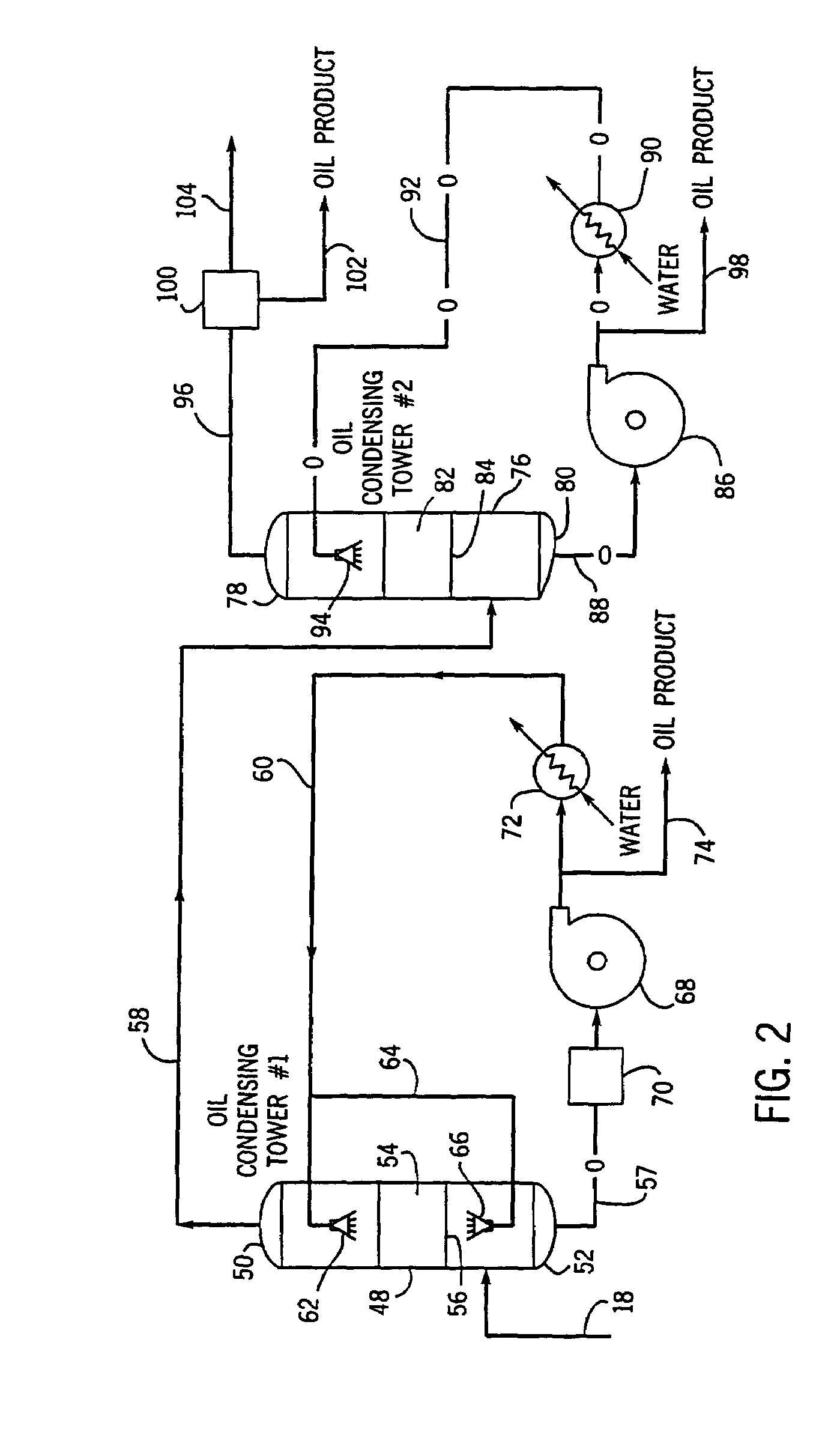Condensation and recovery of oil from pyrolysis gas
a technology of pyrolysis gas and condensation, which is applied in the direction of destructive distillation, gaseous mixture working up, separation process, etc., can solve the problem of unobtainable oil/water emulsion which is difficult to separate, and achieves high void fraction, prevent clogging of the nozzle, and high surface area
- Summary
- Abstract
- Description
- Claims
- Application Information
AI Technical Summary
Benefits of technology
Problems solved by technology
Method used
Image
Examples
example 1
[0032]The following is sample data that may be used to size a 100 ton per day tire pyrolysis plant built in accordance with FIG. 2.
[0033]
Tower 48Diameter = 30 inchesHeight = 26 feetFeed inlet line 18Gas temp. = 850° F.Sump outlet line 57Oil temp. = 150° F.Heat exchanger 72 cooling waterWater temp. = 85° F.Flow rate = 300 gpmOil recycle line 60Oil temp. = 90° F.Flow rate = 175 gpmTower outlet line 58Gas temp. = 212° F.Tower 76Diameter = 24 inchesHeight = 10 feetSump outlet line 88Oil temp. = 100° F.Heat exchanger 90 cooling waterWater temp. = 85° F.Flow rate = 70 gpmOil recycle line 92Oil temp. = 90° F.Flow rate = 85 gpmTower outlet line 96Gas temp. = 100° F.
example 2
[0034]The following is a chart showing the composition of oil collected in a pilot plant study from a system constructed as illustrated in FIG. 2 for two different sources of tires, i.e. Source 1 was from used automobile tires, and Source 2 was from reject or off-spec OEM automobile tires.
[0035]
Distri-ViscosityPourConradsonPentanebution(Centis-PointCarbonInsolublesSpecificCarbonHydrogenSulfurAsh(Wt. %)tokes)(° F.)(Wt. %)(Wt. %)Gravity(Wt. %)(Wt. %)(Wt. %)(Wt. %)Source 1 (used Auto Tires)Primary83.5%6.27−227.90.970.9987.858.671.180.04Secondary2.6%0.95Demister13.8%0.893−221.20.070.8786.319.480.850.01Source 2 (Off-spec OEM Auto Tires)Primary85.2%13.10−2211.25.11.0387.818.181.320.09Secondary4.0%0.97Demister10.8%0.952−221.90.70.8987.379.320.490.01
example 3
[0036]The following is a chart showing a typical non-condensable gas analysis for the product obtained from line 104 in a tire pyrolysis pilot plant constructed as illustrated in FIG. 2.
[0037]
PUM
| Property | Measurement | Unit |
|---|---|---|
| Fraction | aaaaa | aaaaa |
| Flash point | aaaaa | aaaaa |
| Flash point | aaaaa | aaaaa |
Abstract
Description
Claims
Application Information
 Login to View More
Login to View More - R&D
- Intellectual Property
- Life Sciences
- Materials
- Tech Scout
- Unparalleled Data Quality
- Higher Quality Content
- 60% Fewer Hallucinations
Browse by: Latest US Patents, China's latest patents, Technical Efficacy Thesaurus, Application Domain, Technology Topic, Popular Technical Reports.
© 2025 PatSnap. All rights reserved.Legal|Privacy policy|Modern Slavery Act Transparency Statement|Sitemap|About US| Contact US: help@patsnap.com



